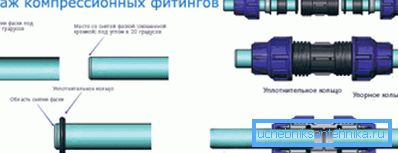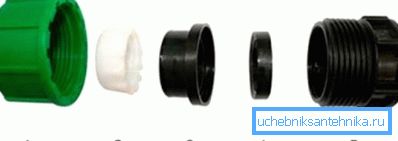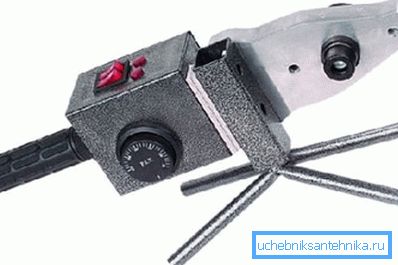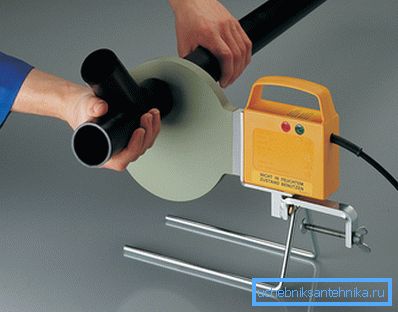Plumbing pnd do it yourself - installation features
In the market of materials for communications one of the leading positions is occupied by pipes made of HDPE (low pressure polyethylene). They have a number of positive qualities, among which is the ease of installation, which makes it possible even non-specialists to collect water supply. Below we take a closer look at how the installation of water supply from PND pipes.

General information
PND is reliable and at the same time durable material.
Among its advantages are the following qualities:
- Corrosion resistance;
- Chemical Resistance (acids and alkalis);
- Good ductility, so that the pipes can be bent on small torsions.
- Ease of processing - products from it are easily cut.
- Low price.
- It has dielectric properties.
- Low weight.
- Slight thermal expansion.
The only thing that should be noted is that polyethylene is unstable to high temperatures, as it softens already at 80 degrees Celsius. Accordingly, it is not suitable for heating systems, however, is an excellent option for cold water.

Below we give the characteristics of the HDPE pipe:
| Tensile strength | 3-5 MPa |
| Minimum Permissible Operating Temperature | 0 degrees Celsius (at a lower temperature, the material glazes and cracks). |
| Maximum working fluid temperature | 40 degrees - for large values, the product begins to lose ring stiffness. |
Preparatory work
Before you begin to build the pipeline, you must do some preparatory work:
- First of all, it is necessary to complete the scheme of the future system with an indication of all twists, forks, the location of the stop valves, etc.
- Further, on the basis of the resulting scheme, you should perform the calculation of materials.
After that, you need to make the purchase of materials, and you can proceed to the device system.

Assembly of water supply
The water supply system from HDPE can be assembled in two ways:
- With the help of compression fittings - in this case no special equipment will be needed.
- With the help of diffuse welding for pipes - for this you will need a special soldering iron, which is used for the installation of polypropylene pipe.
I must say that there are two more ways to join this material - butt welding and with the help of an electrofusion. However, they are not used for self-assembly, since they require special skills, so we will not consider them.
Tip! If the pipeline is mounted indoors, it can be mounted on the walls with special clamps.

Assembly using compression fittings
The use of compression (collet) fittings is the most common method of installation of polyethylene pipes of small diameter (up to 110 millimeters). In other words, when assembling domestic water pipes, this method of assembly is usually used.
Instructions for connecting a pipe with a coupling or other fittings are as follows:
- First of all, you need to carefully cut the pipe so that the cut is perpendicular to its axis. Ideally, this work should be done with a special pipe cutter.
- After that, you need to eliminate burrs and other irregularities.
- Next, you need to chamfer width of two to three millimeters from the edge, to get a cone.

- After that, the pipe should be put on the elements of the compression connection in this order:
- Clamping nut;
- Tightening ring, which is also called the collet;
- Retaining ring;
- And last of all, a sealing ring is put on the edge of the chamfer.
- Then the end of the pipe, which will be immersed in the fitting, must be lubricated with sanitary grease.
- Next, the pipe is inserted into the fitting pipe, after which the clamping nut is screwed on.
Note! Tighten the clamping nut only with your own hands, or with a special plastic key. If you use pliers or another tool, the connection may be damaged.
In the same way, all other water supply connections are mounted. After starting up the water in the system, make sure that all connections are tight. If necessary, they should be slightly tightened.

Diffuse welding
HDPE plumbing using diffusion welding is going quite simply:
- First of all, the machine must be heated to operating temperature. To do this, it must be plugged in and wait until the green light comes on.

- Then the connected parts are inserted into the heated nozzles. In this position, they need to hold until the plastic melts. The exact time is indicated in the table that comes with the soldering iron.
- After that, the parts are pulled out of the nozzles and connected. In such a position, without moving or twisting, they must be held until the molten polyethylene is completely cured.
Tip! To perform a high-quality soldering process, some skill may be required. Therefore, before proceeding to the assembly of the pipeline, you should practice on scraps of pipes.
According to this scheme, all elements of the pipeline are mounted. After completion of the work, as in the previous case, you need to perform system testing.
Conclusion
As we found out, it is up to each home master to do the water supply from the HDPE pipe independently. The only thing you need to do the work very carefully, in the above sequence. In this case, all connections will be sealed and durable.
From the video in this article can be found with additional information on this topic.